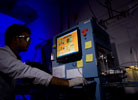Research grant and contract expenditures by University of Houston Cullen College of Engineering faculty totaled more than $21.8 million in fiscal year 2009, the largest ever on record.
Up some 50 percent from the previous fiscal year’s total, primarily the federal government—the National Institutes of Health, the National Science Foundation and the U.S. Department of Energy—supported the research.
A significant milestone for the college, the jump in annual research expenditures is among the initiatives outlined in an 18-page strategic plan critical in helping boost the college’s status by securing a spot as a nationally ranked, top 50 program.
“Our strategic plan outlines an aggressive push for the college to become competitive on the national level,” said Elizabeth D. Rockwell Endowed Chair and Dean Joseph Tedesco. “Research expenditures are at the core of this push and I’m excited to see the college moving in the right direction.”
The increase represents a three-year rise in expenditures at the college—going from a consistent $11.5 million during 2005 to 2007 to $14.4 million in 2008 and now $21,889,978.
The extra few million in fiscal year 2009, Associate Dean of Administration and Research Fritz Claydon said, was not only important for the college, but also one of the key factors in making discoveries that lead to a strong future economy. Expenditures throughout the year helped drive scientific innovations in areas of national and regional need—nanomaterials, energy and sustainability—all of which are emphasized in the strategic plan.
Energy accounted for the single largest category of expenditures of sponsored research funds with the majority going toward cleaning up the air through the creation of technologies that aim to reduce the amount of harmful toxins emitted from vehicle exhaust without sacrificing fuel efficiency.
Three professors—Charles Rooks, adjunct professor of chemical and biomolecular engineering and director of the Texas Diesel Testing and Research Center; Michael Harold, professor of chemical and biomolecular engineering; and John and Rebecca Moores Professor of Chemical Engineering Vemuri Balakotaiah—alone were responsible for more than $7 million in this category.
Expenditures for nanomaterials research, focused on advancing the understanding of how materials behave on the nanoscale, also ranked high on the list. Dmitri Litvinov, professor of electrical and computer engineering, led efforts in this area. He used $725,000 to helped further this science and purchase a dual-beam focused ion beam system—UH’s first true nanofabrication tool.
Other leading categories included student success and innovations related to health and sustainability—encompassing everything from a program designed to enrich the education of UH graduate students while engaging schoolchildren and teachers from the Greater Houston area in physical sciences to research, totaling close to $1.5 million by Civil and Environmental Engineering Professor Hanadi Rifai, to improve water quality.
Among the reasons cited for the increase were new large-scale multidisciplinary projects, Claydon said.
